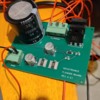Hi all,
It has been a few years since I posted on here and last time I mentioned about working on a circuit to perform grade crossing flashing on old Lionel 154s, or similar incandescent bulb crossings.
I'm happy to announce recently I've gone back to this and have finished it and replicated it multiple times and have actually made prototype boards. The theory makes sense and it's fairly robust from testing I've performed.
The idea is to have 5 wires coming from the module: 2 for AC in, 1 for GND on bulb terminal, and 2 for bulb terminals. Once AC is supplied the bulbs with flash at a 1 second period and 50% duty cycle.
Video https://youtu.be/VThu2PFCFQs
Now that being said, I am going to do a couple things on this thread:
1. Provide the BOM of the circuit and schematic so you can build it yourself. I can provide support to help you debug or build it via direct message or email if you'd like.
2. Start an eBay store (eventually) to sell these boards for you to plug and play. I was thinking about $20, but I want to understand an interest for it first and see if that seems reasonable for those who do not want to build it themselves.
That being said, I would be curious if the community is interested in this as a whole to be sold. If not, no big deal, would be happy to provide support for the ones who want to build it. Or I could even provide a kit to build it for a cost as well with instructions. Let me know if this is of interest!
Thanks,
James






















